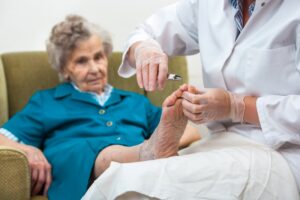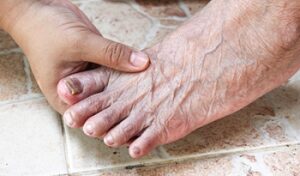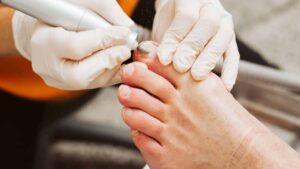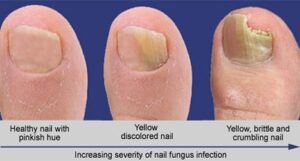As we age, proper toenail care for elderly becomes increasingly important for maintaining overall health and comfort. Older adults often experience foot-related issues such as thickened nails, fungal infections, and other common foot problems due to natural aging, decreased mobility, and health conditions like diabetes. With careful attention to foot care for seniors, seniors can prevent discomfort and infections, improving their quality of life and mobility.

The feet and nails undergo changes with age, often requiring more specialized care than younger feet. Senior toenails tend to grow more slowly, become brittle, and may thicken over time. This can make regular trimming difficult, leading to complications if left untreated. Proper toenail care for elderly individuals helps prevent a range of foot issues such as ingrown toenails, infections, and discomfort while promoting healthier and safer feet.

Here are the essential steps for toenail care for elderly individuals that caregivers and family members can easily follow or assist with:
Seniors should trim their toenails at least once a month to avoid overgrowth and reduce the risk of ingrown toenails. It’s best to cut nails straight across and file down sharp edges to prevent snags. Thickened nails may need soaking in warm water for about 10 minutes to soften before trimming.
Maintaining clean and well-moisturized feet is a key aspect of foot care for seniors. Regularly washing feet with mild soap and warm water removes dirt and bacteria, while applying a gentle moisturizer helps prevent dryness and cracking. Avoid moisturizing between the toes, as this can lead to fungal infections.
Thick and brittle toenails are common in elderly individuals. Soaking feet in warm water can soften nails before trimming, making the process easier and reducing the risk of injury. Seniors with especially thick toenails may consider consulting a podiatrist for safe trimming.

For effective foot care for seniors, checking for signs of infection, changes in nail color, or sores on the feet is essential. Early detection of issues such as fungal infections or corns allows for faster treatment and prevents complications. Those with limited mobility should ask family or caregivers for assistance in checking their feet regularly.
Keeping feet dry and wearing clean, well-fitting socks daily helps prevent fungal infections, which can lead to nail issues. Breathable shoes that offer adequate support and prevent crowding of the toes are essential for reducing pressure on toenails and maintaining healthy feet.
Elderly individuals face a range of toenail and foot issues, each requiring different care approaches:
Ingrown toenails can be painful and lead to infection. To avoid them, seniors should cut nails straight across and avoid cutting them too short. A podiatrist can help with severe cases.
Toenail fungal infections, characterized by thickened, discolored nails, are common among seniors. Maintaining dry, clean feet and using antifungal treatments as needed can help. For severe infections, medical intervention may be required.
Thickening of nails is common with age, often requiring specialized trimming techniques. Using a nail file to smooth edges can help, and soaking nails in warm water before trimming can make this process easier.
Seniors often develop calluses and corns due to repeated pressure. Regular exfoliation with a pumice stone and moisturizing can prevent these, while avoiding shoes that are too tight or have thin soles.
For seniors with health conditions like diabetes or arthritis, regular visits to a podiatrist are beneficial. Professional foot care for seniors can help address specific needs and prevent complications. Conditions that may warrant professional assistance include:
For caregivers, understanding and assisting with toenail care for elderly can greatly improve a senior’s comfort and health. Here are a few tips to make toenail and foot care easier:

For those who cannot manage their own foot care due to mobility limitations or health concerns, professional services like in-home foot care can make a huge difference. Many services provide home visits for foot care for seniors, which can include toenail trimming, callus removal, and basic foot care routines tailored to each individual.
Professional care is particularly beneficial for seniors with diabetes, arthritis, or circulatory issues, as they are at higher risk for foot problems. By entrusting toenail care to trained professionals, seniors can feel more comfortable and reduce the risk of infections or complications.
Maintaining proper toenail care for elderly individuals is essential for promoting foot health, preventing infections, and enhancing mobility. Whether managed independently, with the help of a caregiver, or through professional podiatric care, regular foot care for seniors helps to preserve overall health and comfort. For the elderly, consistent foot care is more than just a routine—it’s a critical component of maintaining a healthy and active lifestyle.